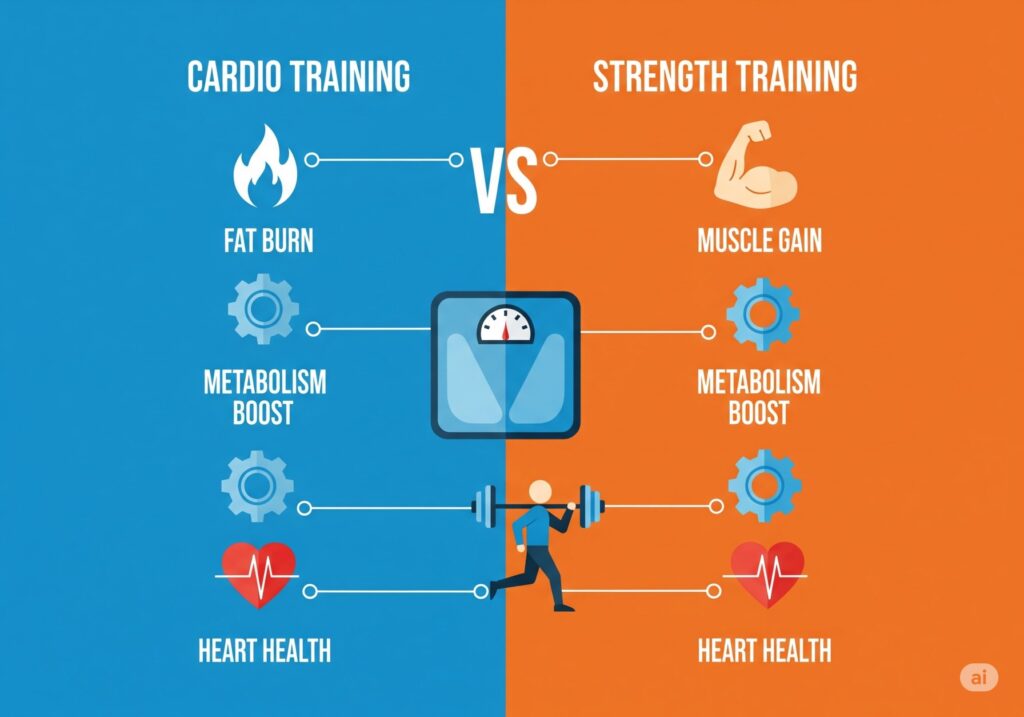
Featured image showing cardio vs strength training in a split-screen design
Cardio vs strength training explained: what burns more, what preserves muscle, and how to mix both for sustainable weight management.
Why “cardio vs strength training” is the wrong question
We often frame it as a fight. But weight management is multifactorial. Diet, sleep, stress, and movement all matter. Even so, choosing how you exercise still counts. Cardio typically burns more calories per session. Strength training preserves or builds lean mass, which supports your resting metabolism. Together, they work best. That’s not just opinion—it is what the research shows. PMC, PubMed, AHA Journals
What the science says about fat loss

Large trials comparing aerobic training with resistance training find aerobic work reduces body weight and fat mass more efficiently per minute invested. Meanwhile, resistance training is superior for increasing lean mass. In one well-cited randomized trial, aerobic training alone cut fat mass the most, while adding resistance training mainly added time and muscle—useful for health and shape—even if it didn’t amplify fat loss in that study. PMC
Meta-analyses since then refine the picture. When comparing modes head-to-head, aerobic training and concurrent training (cardio + strength) reduce absolute fat mass more than resistance training alone, while percent body-fat changes can be similar, especially over shorter programs where total work is matched. In short: if fat-mass reduction is the singular goal, cardio or a cardio+strength mix tends to win; but lifting doesn’t “block” fat loss. PubMed
HIIT or steady cardio for weight control?
You might have heard that high-intensity interval training (HIIT) melts fat faster. The evidence is mixed. Several reviews conclude that HIIT and moderate-intensity continuous training (MICT) deliver similar fat-loss outcomes when total energy expenditure is matched. HIIT can be time-efficient and improve fitness quickly, but it is not a magical shortcut for fat loss compared with steady cardio. PMC+1, ScienceDirect
A 2024 umbrella analysis also links meeting ~150 minutes per week of aerobic exercise with meaningful reductions in waist circumference and adiposity, regardless of whether those minutes are spent in intervals or steady state. Consistency, not novelty, is the secret. JAMA Network
The metabolic advantage of strength work

Now, here is where resistance training shines. It increases or preserves fat-free mass. That helps maintain resting energy expenditure as you diet, protecting against the “metabolic dip” that can make weight maintenance harder. It also improves insulin sensitivity, bone density, and functional capacity—benefits that matter for long-term health and for how you look and feel at the same scale weight. PMC, AHA Journals
Official guidelines still favor a blend
Leading bodies recommend both weekly cardio and strength work. The American College of Sports Medicine (ACSM) and CDC advise at least 150 minutes of moderate-intensity aerobic activity (or 75 minutes vigorous) plus muscle-strengthening activities on 2+ days per week. The American Heart Association and U.S. Physical Activity Guidelines echo the same targets. This “and/also” approach aligns with research showing that combined training best improves cardiometabolic risk. ACSM, www.heart.org, CDC, Health.gov, AHA Journals
Cardio vs strength training: which is better for weight loss?
For pure fat-mass reduction in a fixed training time, cardio has a slight edge. It typically expends more calories during the session. Multiple trials and reviews show greater absolute fat-mass losses with aerobic or combined training than with resistance training alone. PMC, PubMed
Cardio vs strength training: what about body composition?
If you care how your weight is distributed (fat vs muscle), resistance training is essential. It maintains or adds lean mass while you lose fat, improving body composition and aiding maintenance. The best “look and feel” outcomes usually come from a blend. PMC, AHA Journals
Cardio vs strength training: building a weekly plan
Short sentences. Clear targets. Here is a practical, research-aligned template:
- Cardio base: Aim for 150–300 minutes/week moderate intensity (brisk walking, cycling, swimming). Or do 75–150 minutes/week vigorous (running, hard cycling). Mix as you like. Spread over 3–6 days. CDC, Health.gov
- Strength minimum: Train 2–3 days/week. Focus on compound moves: squats, hinges, pushes, pulls, carries. 6–12 reps, 2–4 sets, progressive overload. ACSM
- Optional HIIT: Add 1–2 short HIIT sessions if you enjoy it or are time-crunched. Keep the total work sensible. Results are similar to steady cardio when energy is matched. PMC
- Move more daily: Increase NEAT (steps, standing, chores). These “background” calories support weight control. (General public-health guidance supports more total movement throughout the day.) CDC
Cardio vs strength training: ordering your workouts
If you combine both in one session, doing weights first may help you lift better and, in some studies, may slightly improve strength and fat-loss outcomes. But the biggest win is picking an order you can stick to consistently. Health
Cardio vs strength training: nutrition still rules the scale
You cannot out-exercise a chronic calorie surplus. Exercise drives health and helps keep weight off, but diet quality and total intake determine the speed and size of fat loss. Reviews and expert guidance repeatedly emphasize pairing training with nutrition for the best results. Think protein-forward meals, fiber-rich plants, and mostly minimally processed foods. The Times
Cardio vs strength training: making it sustainable
Progress comes from habits. Choose modes you enjoy. Track simple metrics: steps, minutes, sets, and sleep. Progress your strength by adding a little weight, reps, or sets. Progress your cardio by adding minutes, hills, or intervals. Small, steady changes beat heroic, short-lived bursts.
Sample 4-week template you can start tomorrow
- Weeks 1–2
- Mon: Full-body strength (45 min).
- Tue: Brisk walk or cycle (30–40 min).
- Wed: Rest or mobility (10–15 min).
- Thu: Full-body strength (45 min).
- Fri: MICT cardio (30–40 min).
- Sat: Optional HIIT (10–20 min).
- Sun: Long easy walk (40–60 min).
- Weeks 3–4
- Increase each strength exercise by 1–2 reps or add 2–5% load.
- Add 5–10 total minutes to weekly cardio.
- Keep one easy day. Keep one long walk.
This plan hits guideline minutes, builds muscle, and stays sustainable. CDC, Health.gov
External resources (helpful primers)
- ACSM overview of physical activity guidelines – quick reference for weekly targets. ACSM
- CDC adult activity basics – clear, consumer-friendly summaries. CDC
- AHA recommendations for adults – heart-health perspective on minutes and intensity. www.heart.org
Bottom line
If your goal is faster fat-mass reduction, cardio (or cardio plus some lifting) is usually more efficient. If your goal is lasting weight management and a better shape and metabolism, do both. Cardio drives the energy burn and heart health. Strength training preserves the engine that keeps calories burning 24/7. The winner in “cardio vs strength training” is the combo you will actually do, week after week. PMC, PubMed, AHA Journals
Medical Disclaimer: This article is for informational purposes only and should not be taken as medical advice. Always consult a qualified healthcare professional before starting or changing any exercise or diet program.
Call to Action: Ready to take control of your health? Start by combining cardio and strength training in your weekly routine. Share this article with a friend who wants to improve their fitness, and begin your journey to sustainable weight management today







